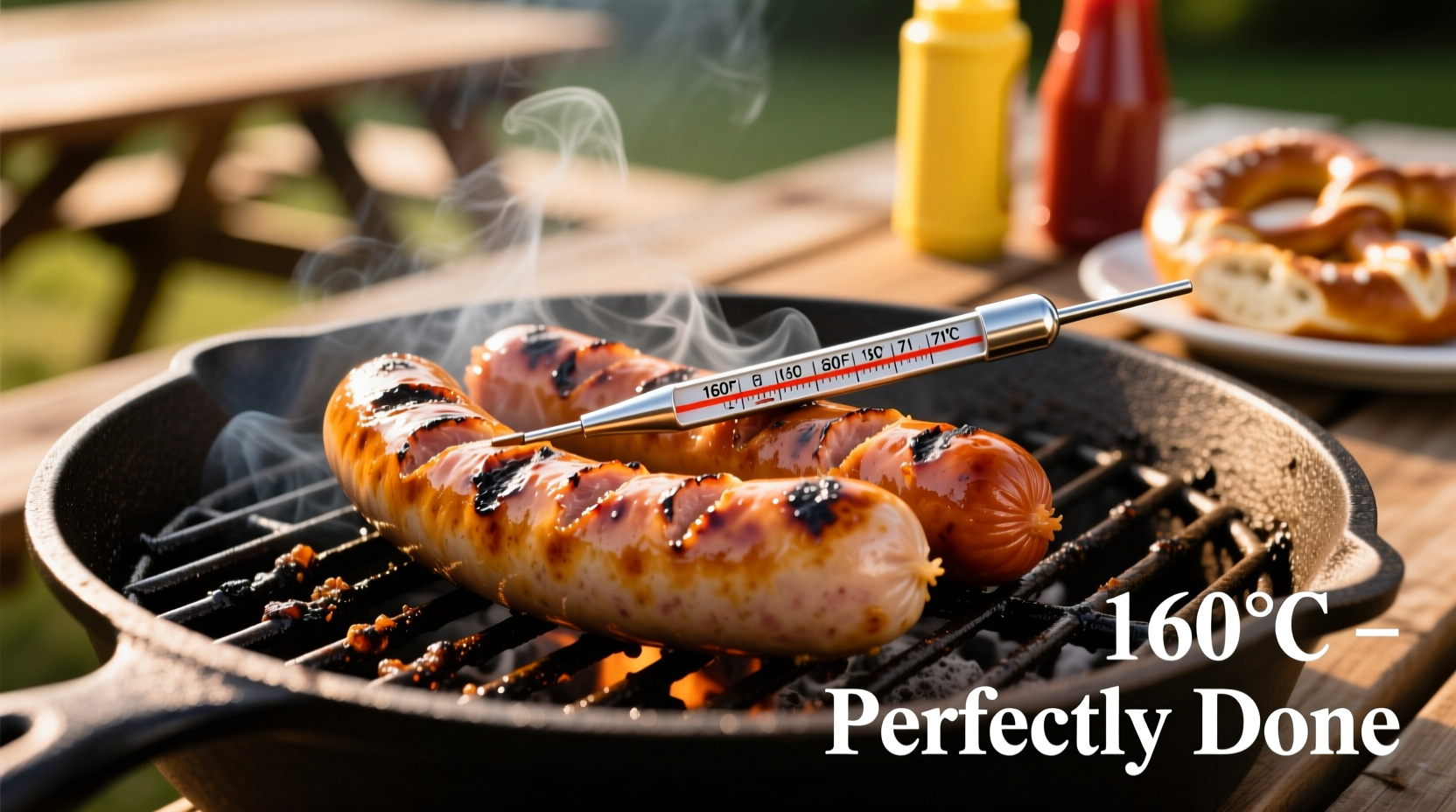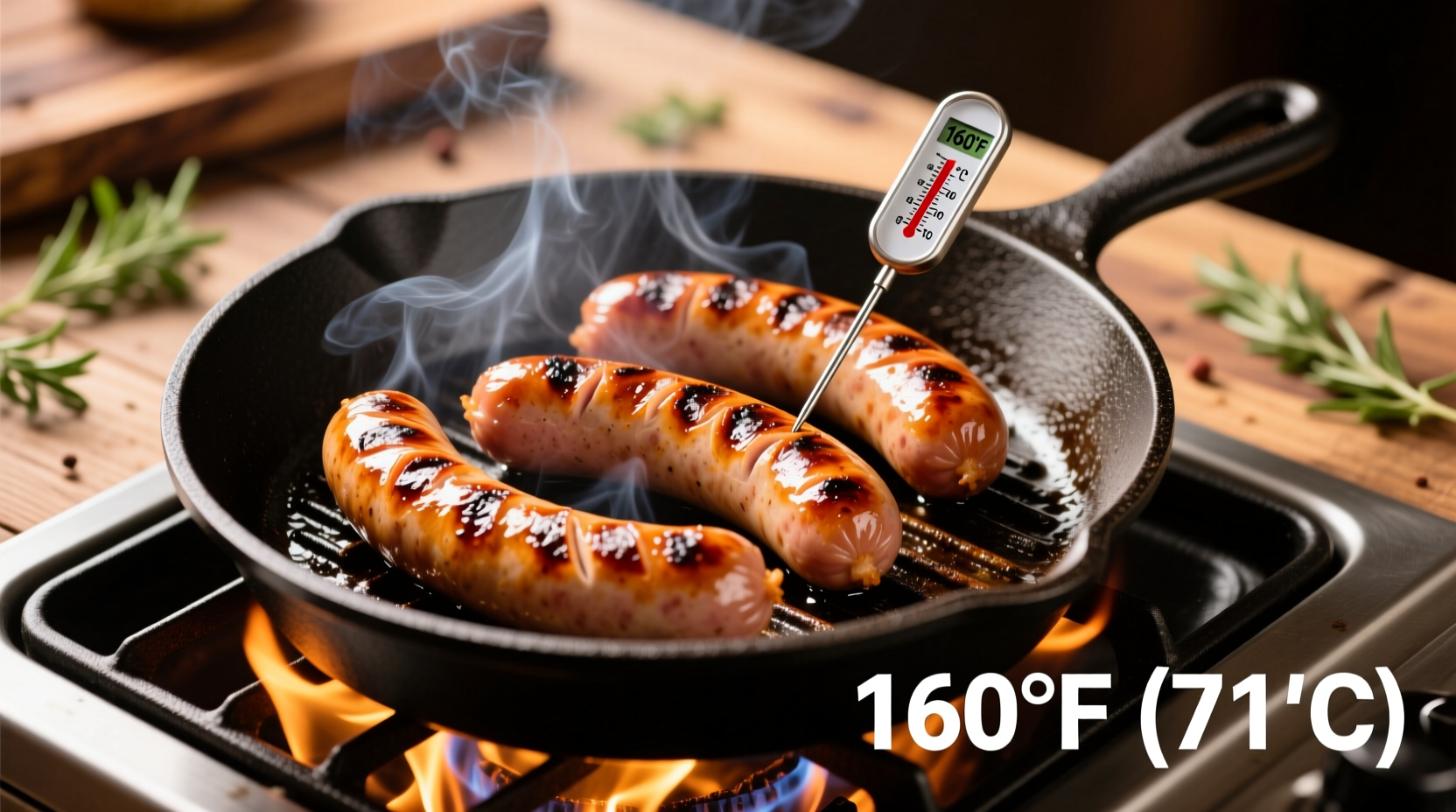The ideal internal temperature for perfectly cooked brats is 160°F (71°C). This temperature ensures food safety while maintaining optimal juiciness and flavor. Use an instant-read thermometer inserted into the thickest part of the sausage for accurate measurement.
As someone who's spent decades exploring European culinary traditions, I've seen how precise temperature control transforms simple bratwurst from ordinary to extraordinary. Getting the temperature right isn't just about safety—it's the key to achieving that perfect balance between juicy interior and beautifully caramelized exterior that defines exceptional bratwurst.
Why 160°F Is the Magic Number for Brats
Understanding the science behind cooking temperatures separates novice cooks from those who consistently produce restaurant-quality results. The USDA Food Safety and Inspection Service establishes 160°F (71°C) as the minimum safe internal temperature for pork products, which includes most traditional bratwurst varieties.
At this critical temperature point:
- Harmful bacteria like Salmonella and E. coli are completely eliminated
- Fat renders properly, creating that signature juicy texture
- Proteins reach optimal coagulation without squeezing out excessive moisture
- Flavor compounds develop fully through the Maillard reaction
| Temperature Range | Effect on Bratwurst | Food Safety Status |
|---|---|---|
| Below 140°F (60°C) | Raw appearance, unsafe bacteria present | Unsafe - Danger Zone |
| 140-150°F (60-65°C) | Pink center, slightly firm texture | Risky - Not Recommended |
| 155-160°F (68-71°C) | Slightly pink, juicy, fully safe | Safe - Optimal Range |
| Above 165°F (74°C) | Dry, crumbly texture, diminished flavor | Safe but Overcooked |
How to Measure Brat Temperature Accurately
Many home cooks make critical errors when checking bratwurst temperature. Follow these professional techniques for reliable results:
- Choose the right thermometer: Instant-read digital thermometers provide the most accurate readings for thin sausages. Dial thermometers often lack precision for items under 1 inch thick.
- Insert properly: Place the probe tip into the thickest part of the brat, avoiding contact with the casing or cooking surface. Insert sideways rather than from end to end for better accuracy.
- Check multiple spots: Test several brats in different areas of your cooking surface, as heat distribution varies.
- Wait for stabilization: Hold the thermometer steady for 10-15 seconds until the reading stops changing.
"I've seen countless backyard chefs ruin perfectly good brats by guessing doneness," explains Dr. Robert Gravani, food safety specialist at Cornell University. "The only reliable method is using a properly calibrated thermometer."
Cooking Methods and Temperature Management
Different cooking techniques require specific temperature management approaches:
Grilling Brats
For optimal results on the grill:
- Start with indirect heat (300-350°F) to gently bring internal temperature up
- Finish over direct heat (400-450°F) for 2-3 minutes per side to develop caramelization
- Avoid constant flipping—turn only once when internal temperature reaches 140°F
- Remove from heat at 155°F to account for 5°F carryover cooking
Pan-Frying Brats
When cooking indoors:
- Preheat skillet to medium (325-350°F) before adding brats
- Add ¼ inch of liquid (beer, broth, or water) to prevent casing splitting
- Cover pan for first 8-10 minutes to steam interior to safe temperature
- Uncover and increase heat for final browning phase

Context Matters: Different Brats, Different Requirements
Not all bratwurst follows the same temperature rules. Understanding these distinctions prevents cooking errors:
- Traditional pork brats: Require 160°F for safety as pork must reach this temperature to eliminate pathogens
- Pre-cooked brats: Only need to reach 140°F to heat through, though many benefit from higher temperatures for flavor development
- Chicken or turkey brats: Must reach 165°F (74°C) as poultry requires higher temperatures for safety
- Veal-based brats: Follow the same 160°F guideline as pork products
Always check packaging for specific recommendations, as some artisanal varieties may have different requirements based on processing methods.
Avoiding Common Temperature Mistakes
Even experienced cooks make these temperature-related errors:
- The squeeze test: Pressing brats to check firmness is highly unreliable and often results in juice loss
- Color confusion: Pink color doesn't necessarily indicate undercooking—some brats contain curing agents that maintain pinkness
- Thermometer placement: Inserting too close to the casing gives false high readings
- Not accounting for carryover: Removing brats at exactly 160°F often results in overcooking
Resting Time: The Final Temperature Adjustment
Many cooks overlook the critical resting phase after cooking. When you remove brats from heat:
- Internal temperature continues rising 5-10°F during the first 3-5 minutes
- Juices redistribute throughout the sausage, enhancing moisture retention
- Proteins relax, preventing explosive juice loss when cut
For perfect results, remove brats from heat when they reach 155°F and let them rest for 5 minutes before serving. This simple step transforms potentially dry sausages into consistently juicy delights.
Food Safety Timeline: How Temperature Recommendations Evolved
Understanding the historical context of cooking temperatures reveals why precision matters today:
- Pre-1990s: Recommendations varied widely, with many sources suggesting 170°F+ for pork
- 1995: USDA lowered safe pork temperature to 160°F based on improved pathogen research
- 2011: USDA further reduced whole-cut pork recommendation to 145°F with 3-minute rest
- Present: Ground pork products (including brats) maintain 160°F recommendation due to increased surface area exposure
This evolution reflects both improved scientific understanding and changes in pork production methods. The current 160°F standard for ground pork products balances safety with optimal eating quality.
When Thermometers Aren't Available: Visual Indicators
While a thermometer is essential for precision, these secondary indicators can help when one isn't available:
- Juice color: Clear or faintly pink juices (not red) indicate proper cooking
- Texture: Firm but yielding to gentle pressure (not hard or mushy)
- Casing appearance: Golden brown with slight blistering, not splitting
- Cutting test: Interior should be uniformly cooked with no raw-looking areas
However, these methods remain significantly less reliable than thermometer use. The USDA strongly recommends using food thermometers for all meat products.
Leftover Safety: Maintaining Temperature Control After Cooking
Proper temperature management continues after cooking:
- Refrigerate leftovers within 2 hours (1 hour if ambient temperature exceeds 90°F)
- Store in airtight containers at or below 40°F
- Reheat to 165°F before consuming leftovers
- Consume within 3-4 days for optimal safety and quality
Following these guidelines prevents bacterial growth during the critical post-cooking phase.











 浙公网安备
33010002000092号
浙公网安备
33010002000092号 浙B2-20120091-4
浙B2-20120091-4